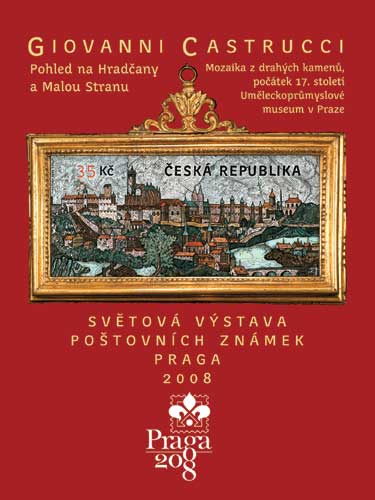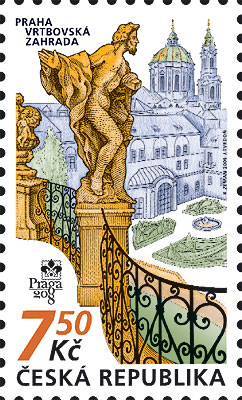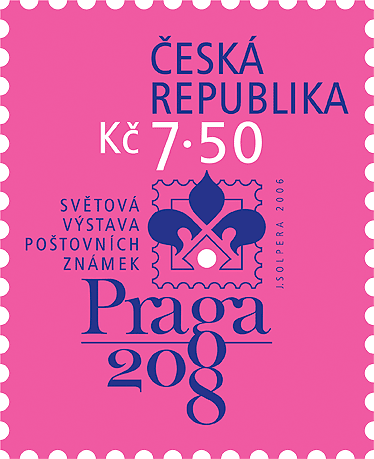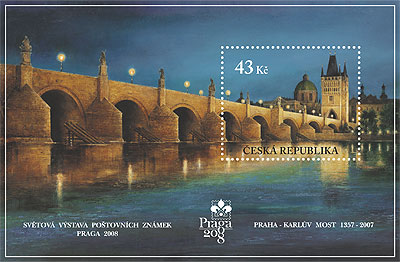![]() Fresh News:
Fresh News:
What stamps will be issued for the world exhibition?
The world exhibition PRAGA 2008 is a big opportunity for the issuers of postage stamps and for Czech Post to present the beauty of Prague on stamps to a greater extent than usual. Prague, being rightly valued as one of the most beautiful cities in the world, will appear frequently on postage stamps, FDCs and postcards in the next two years. The Prague motifs of these issues are very originally conceived, with unusual composition, a view from above, from a distance, using out-of-the-ordinary backgrounds etc. If one takes into consideration the dimensions of stamps and all of the other limiting factors involved in their making, the creative design of a stamp is often more interesting than the composition of the original picture or photograph, and it gives pleasure by its aesthetic effect.

The first issue for the world exhibition PRAGA 2008 was a CZK 35 stamp with a View of Hradčany Castle by Giovanni Castrucci composed on a sheet with a gilded frame and decorative mounting. It was issued on 13 September 2006, and its author is the graphic designer Václav Kučera. The picture of the castle consists of a mosaic of precious stones - commesso in pietre dure – which is designed so that it creates the desired picture through the color and pattern of the precious stones precisely ground into each other. This special technique was brought from Florence to the court of Emperor Rudolph II in Prague by Cosimo and Giovanni Castrucci, who founded a prospering workshop here. Their production represents an independent variant of Florentine mosaic. This technique was frequently used for the trimming of cabinets and chests. The mosaic is printed on the stamp by recess printing from flat plates after an engraving by Václav Fajt, and it is combined with offset printing. The original mosaic is the property of the Museum of Decorative Arts in Prague and was displayed at the magnificent exhibit “Rudolph II and Prague” in 1997. For the first day cover, the author of the issue chose a portrait of Rudolph II drawn by Giuseppe Arcimboldo, another artist in the service of the Emperor, who was famed for his allegories – portraits, landscapes and still-lifes composed from flowers, vegetables and animals.

On 11 October 2006, another stamp was issued promoting the exhibition PRAGA 2008, showing the Vrtba Garden in Prague, one of Europe’s most beautiful baroque gardens, spread at the foot of Petřín Hill by the Vrtba Palace in the Lesser Town. This Italian-style garden was designed in 1715 - 1720 by the architect František Maxmilián Kaňka for Count von Wrtby. Participating in the garden’s decoration were outstanding artists of the high baroque – the sculptor M. B. Braun, the painter V. V. Reiner and the plasterer T. Soldati. The effect of the garden is based on the gradations of terraced areas joined by stairs and supported by walls shaped in typical baroque curves. Joining the garden and the palace is a salla terrena adorned with frescoes and sculpture. The central terrace with a little pool and fountain consists of a high supporting wall with a conical balustrade and a double-flight stairway adorned with statutes of the gods of antiquity and baroque vases. Depicted on the CZK 7.50 stamp is part of that sculptural decoration with a view to the Vrtba Palace and the tower of the St. Nicholas Church. The author of the artistic design of this issue is Karel Zeman, and the engraving is by Jaroslav Tvrdoň. On the coupon is a relief of water sprites also from the decorations of the Vrtba Garden. The stamp is printed by rotarg recess printing with combined style gravure printing.
Scheduled for 1 December 2006 is the release of a postage stamp for the promotion of the world exhibition. It is a small stamp with a face value of CZK 7.50 and the entire picture consists of the logo of the exhibition PRAGA 2008. The logo and the stamp were designed by Jan Solpera. The stamp was made by offset printing.

In accordance with tradition, in the first half of 2007 two commemorative postcards with a value of CZK 7.50 and CZK 10 will be released. They will have stamps with architectural symbols of Prague, and their pictures will show the venues where PRAGA 2008 will take place. The postcard for CZK 7,50 will depict the Palace of Industry at the Prague Exhibition Grounds in Prague 7 – Holešovice, and the CZK 10 postcard will show the interesting interior of the Postal Museum.
.jpg)
The Prague Lesser Town district will celebrate its 750th anniversary in 2007. One of the most attractive parts of Prague with an inimitable atmosphere and the charm of a historical city, it is a protected historical monument zone. The Czech King Přemysl Otakar II founded the Lesser Town at the foot of Prague Castle at the site of the present-day Lesser Town Square. The new town beneath Prague Castle began to be called the Lesser Town of Prague in the 14th century. Emperor Charles IV greatly expanded this city by incorporating adjacent settlements and the building of new parapets (the so-called Hunger Wall). The present-day appearance of the Lesser Town dates mainly from the 17th and 18th centuries, when imposing baroque palace, churches and monasteries were built there. In 1784 it ceased to be an independent city and became one quarter of the united City of Prague.
.jpg)
Used on the stamp for the anniversary of the Lesser Town is a detail from Langweil’s model of Prague that, besides the Old Town and Jewish Town, Hradčany without Strahov and part of Nový Svět, also includes the Lesser Town without the slopes of Petřín Hill. Langweil’s model of Prague is a unique document, a work of art and a rarity. Created in 1826 – 1837, its author is Antonín Langweil (1791 -1837), who had been working on a model of Prague since 1822. The immediate inspiration for his creation, however, was the Prague exhibit of a model of Paris by S. Caron in 1826.
Langweil’s model is 5.76 m long and 3.24 m wide. The façades, sidewalks, walls and fences are drawn on paper, further colored and glued onto hard pasteboard. Roofs and pavement are only partially hand drawn, and are mostly made by lithography. Chimneys, church steeples and part of the terrain are made of wood. The model’s maker captured with maximum precision the color of the façades, the house emblems, signs and house numbers, and he differentiated the various types of roofing. In the courtyards we see piles of wood, low walls and propped-up ladders.
Since the 1950s, the model of Prague has been kept in the Museum of the City of Prague. It is available for public viewing and it is regularly cleaned and restored. Its extraordinary power to describe the appearance of Prague during Langweil’s day before the onrush of construction and changes have made it an invaluable source of information about buildings in a significant portion of Prague.
A CZK 7.50 stamp designed by Václav Kučera will be issued on 14 March 2007. The engraving by Miloš Ondráček will be printed using rotarg recess printing with combined style gravure printing. The stamp will depict Lesser Town Square and the former city hall, the Smiřický Palace and Šternbersk houses on the north side of the square, the Church of St. Nicholas, the former Jesuit school and the blocks of houses in the neighborhood. A half-size coupon will consist of the houses on the southern end of the square.
A picture of the eminent Antonín Langweil and his signature adorn the first day cover. It looks like he is caught just then working on the Prague model.

Another big Prague anniversary will be commemorated on a CZK 43 stamp that will be issued on 20 June 2007. That will be the 650th birthday of Charles Bridge, the foundation stone of which was laid by Emperor Charles IV on 9 July 1357 at exactly 5:31 a.m. The date and time were determined by astrologers. The building of the bridge was entrusted to Petr Parléř and his ironworks. The bridge was originally called the Stone Bridge or the Prague Bridge, and it was not renamed after Emperor Charles until 1870. The structure, 520 m long and 10 m wide and resting on 16 pillars is made of sandstone blocks and ends with bridge towers on both banks of the Vltava River. Most of the baroque statues on the bridge’s railing are copies of works by such famous artists as Matyáš Bernard Braun or the Brokoff family. Some of the statues, destroyed by flooding, have been replace by the work of contemporary sculptors. The bridge still served as an important transportation route in the 20th century, and it was not reserved for pedestrian traffic until 1965. It has become a primary historical monument of Prague and a tourist attraction.
A nighttime view of the illuminated Charles Bridge with the beautiful gothic Old Town Bridge Tower and the baroque dome of the Church of St. Francis is based on playing effectively with the lights not only on the bridge and the adjacent buildings, but also on the water of the Vltava River. The sheet that the stamp blends into smoothly was designed by Adolf Absolon who conceived the pattern for the whole sheet as an original artwork. The engraving in the stamp is by Martin Srb. The sheet will be printed by reces printing combined with offset printing. The FDC’s design, drawn by Pavel Dvorský, depicts the statue of Charles IV on his throne with the Roman imperial crown on his head, which decorates the Old Town Bridge Tower.
Publishing activity to promote and support the exhibition will naturally continue in 2008.
Besides the exhibits of the Prague Postal Museum, a broad assortment of postage stamps will be prepared for visitors to the exhibition PRAGA 2008. Those stamps will be available for purchase at postal counters in Czech Post branches. A whole series of commemorative postmarks and mailing stickers bearing the logo of the exhibition PRAGA 2008 will also be ready there for collectors. Also not to be missed will be the possibility of making popular postage stamps with your own design on a coupon. Philatelists will be able not only to add to their collections of postage stamps, but also to create, for instance, interesting postal packets that will commemorate the World Stamp Exhibition PRAGA 2008 in the coming years.
Jarmila Mykytynová
Head of the Independent Philately Department
Czech Post Board of Management
|
|
|
|
|
